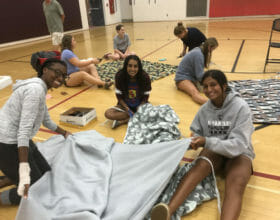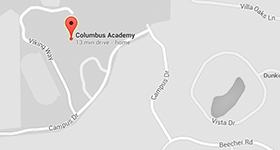Flickr
The Mid-Ohio Food Collective, a hunger-relief network in Central Ohio, serves more than 500,000 individuals per year, but with a $5 million dollar loss in state and federal support this year, organizations like MOFC have been forced to lean on volunteers. “We are simply handing out less food at our sites,” said Jeremy Brauning, a spokesperson for Mid-Ohio. “With COVID, we knew relief was on the way. Now, there is no comparable government support on the horizon. We’re leaning on our community more than ever.” According to Brauning, every $1 donated provides 2.5 meals, and volunteers save the organization more than $3.5 million in manpower. But while donations and volunteers help tremendously, they can’t fully replace the funding gap.
Service Board Advisor, Christy Bening, describes firsthand how critical Academy’s contributions have become. Service Board frequently partners with organizations like NNEMAP food pantry and Westerville Area Resource Ministry (WARM). Additionally, initiatives like our Kids 4 Kids drive provides clothing, and other events such as apple-picking helps tosupply fresh produce to local non profits. “When we do the food drive, we give a super generous supply of weeks’ worth of food and clothing,” said Bening. “They get a really nice infusion of food. Then we send the balance to NEMAP. One of the reasons we partner with them is because they don’t limit who they serve by zip code. They’re in a food desert, and they provide incredible support.”
Unfortunately, families may face limitations regarding how often they can visit pantries, fresh produce always remains difficult to distribute before it spoils. “When the federal money goes away, people still need food,” Bening says. “That means Mid-Ohio and others may have to ration. And at the same time, prices are astronomically high. It’s a weird complication of variables: food banks’ buying power is reduced, prices are going up, and the demand for volunteers is rising.”
Also problematic are food prices that have shot up so intensely that families are cutting back on basics like meats and eggs. Protein alternatives such as peanut butter, beans, rice, and canned tuna are always in high demand, but also have become much more expensive. “People are replacing protein with supplements or buying less, like only a half-pound of meat instead of a full pound,” Bening says, and “It’s forcing families to make impossible choices.” Seniors on fixed incomes are particularly vulnerable. With limited budgets and higher costs, they often have to bulk items and rationalize them over several days. “The cost of food has gone through the roof, and one of the difficulties is having to buy something of a certain size, and eat it for a couple days,” says Bening.
In response, organizations have not backed down and are finding creative solutions. At Academy, Blessing Boxes, which have small outdoor pantries stocked with food, give families and homeless individuals quick access to food. On September 21, our apple picking event supplied more than 1,000 fresh apples to local pantries. Some food banks have begun offering cooking demonstrations and tasting, to help individuals learn how to prepare unfamiliar food items.
Not only has the loss of federal support has changed how services organizations operate around Central Ohio, but also affected many communities that are supported by them. When our government aid is no longer assisting organizations, the community is filling in the gap. “Whether it’s fundraising, volunteering, or advocating, we need neighbors helping neighbors,” said Brauning.








